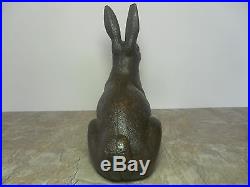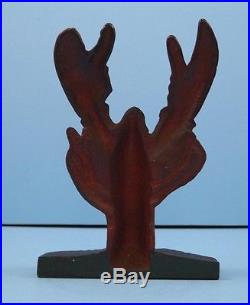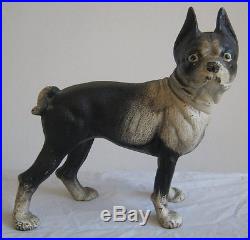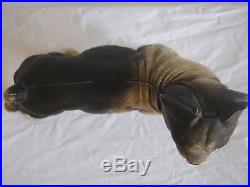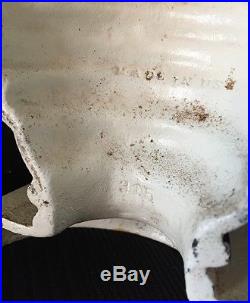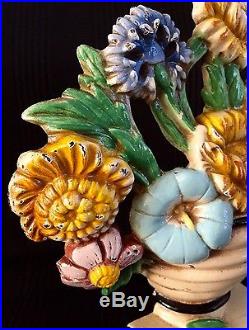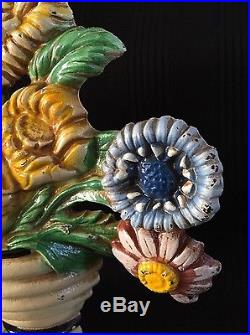


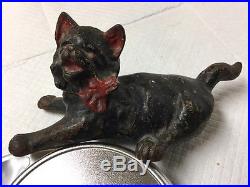

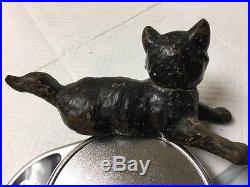





Rare Antique Hubley #122 Cast Iron Doorstop Reclining Kitten Cat with Bow & Fine Original Paint. Measures 8 1/2″ long and 4 1/4″ tall. It is a 2 part casting – the head is a separate cast piece held by screw. It is numbered inside 122 which is the correct number listed in the books. You virtually NEVER find this doorstop available for sale. I acquired it from a local estate sale many years ago and it has been one of my better doorstops in my personal collection. OK – the catalog attributes this as being made by National Foundry but I firmly believe it is much more likely Hubley for 2 reasons = Hubley was known for making 2 part cast doorstops and the font of the number 122 is exactly like what Hubley used. At any rate is is certainly a genuine and rare doorstop. Excellent condition with no damage and great paint all genuine original. The same doorstop is listed on page 121 of The Doorstop Encyclopedia by Smith as shown in the last photo. Guaranteed genuine old vintage as described with original paint. Perhaps the only thing more welcoming than an open door is a brightly colored cast-iron doorstop holding it ajar. Like the best collectibles, these seemingly indestructible household objects are as visually appealing as they are practical, adding a bit of charm and whimsy to any home. Doorstops first appeared in England in the late 1700s. Made of cast brass, they were used to help prop open the heavy English doors, allowing air to better circulate through homes. The earliest doorstops had wooden handles so they could be easily moved. Handles disappeared in the 19th century; by then, cast iron had replaced brass. Most doorstops youll find today were likely made in America sometime between the turn of the last century and 1940. They hit their peak of popularity during the 1920s and 30s. It is hard to determine the age of a doorstop simply by its design, as some of the most popular styles were manufactured for decades. Motifs were numerous: rose-covered cottages, ships, lighthouses, windmills, covered wagons, trains, baskets of flowers or fruit, ladies in fine dress, children, gnomes, holiday and fairy-tale figures, cats, dogs, cartoon characters, and more. Nearly all examples featured brightly colored enamel paint. Manufacturers included Hubley in Lancaster, Pennsylvania; Bradley & Hubbard in Meriden, Connecticut; Wilton Products Inc. In Wrightsville, Pennsylvania; Albany Foundry in Albany, New York; and A. Greenblatt Studios in Boston. Most makers ceased production with the onset of World War II, but not all: John Wright Co. In Wrightsville, Pennsylvania, now reproduces some of the original Hubley patterns. Though age is not the determining factor in assessing the value of a doorstop, a reproduction of an earlier pattern is worth a fraction of the price of the original. Condition, paint surface, and rarity of the design are very important to collectors. Rust and repainting can drastically affect values. The best advice for determining whether a doorstop is truly vintage, not reproduction, is to examine the surface closely. Does the wear look inconsistent with use? Is the paint too shiny? Run your hand over it a real vintage doorstop will feel smooth, whereas a reproduction will have a rough, sandy surface. Also, seams on reproductions are often mismatched, and pieces are sometimes painted on the back side. Original manufactures never were. The item “Rare Antique Hubley Cast Iron Doorstop Reclining Kitten Cat w Bow Original Paint” is in sale since Sunday, February 28, 2016. This item is in the category “Antiques\Decorative Arts\Metalware”. The seller is “spooknook” and is located in Weymouth, Massachusetts. This item can be shipped worldwide.









